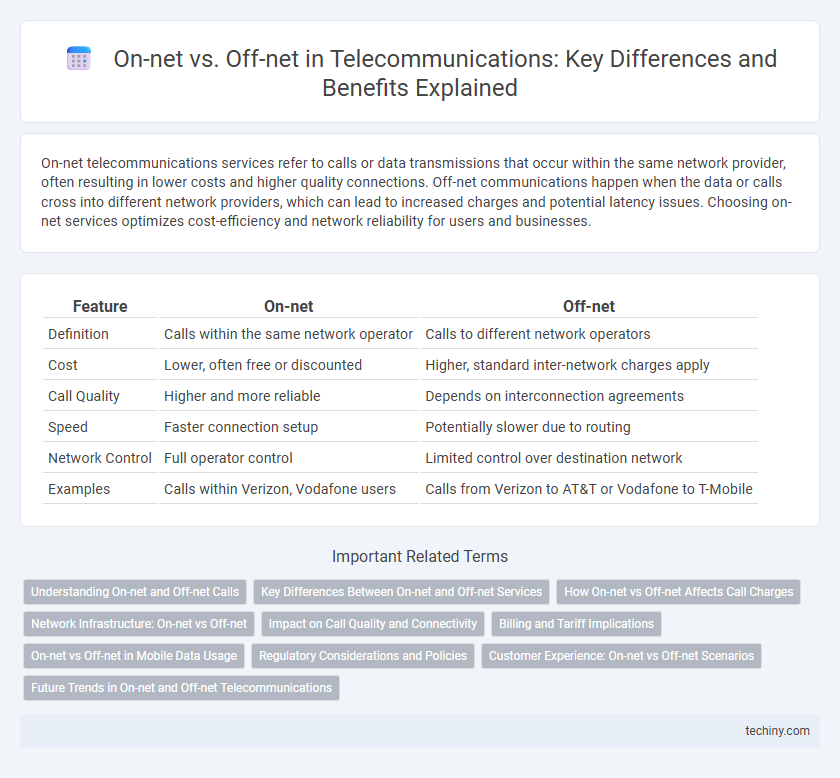On-net telecommunications services refer to calls or data transmissions that occur within the same network provider, often resulting in lower costs and higher quality connections. Off-net communications happen when the data or calls cross into different network providers, which can lead to increased charges and potential latency issues. Choosing on-net services optimizes cost-efficiency and network reliability for users and businesses.
Table of Comparison
| Feature | On-net | Off-net |
|---|---|---|
| Definition | Calls within the same network operator | Calls to different network operators |
| Cost | Lower, often free or discounted | Higher, standard inter-network charges apply |
| Call Quality | Higher and more reliable | Depends on interconnection agreements |
| Speed | Faster connection setup | Potentially slower due to routing |
| Network Control | Full operator control | Limited control over destination network |
| Examples | Calls within Verizon, Vodafone users | Calls from Verizon to AT&T or Vodafone to T-Mobile |
Understanding On-net and Off-net Calls
On-net calls occur within the same telecommunications network, offering lower costs and higher call quality due to optimized routing and reduced reliance on external infrastructure. Off-net calls connect users across different networks, often resulting in higher charges and potential signal degradation because they traverse multiple carriers and interconnect points. Understanding the distinction between on-net and off-net calls helps businesses optimize communication expenses and enhance service reliability.
Key Differences Between On-net and Off-net Services
On-net services operate within a single telecommunications provider's network, enabling direct routing and typically offering lower costs and higher call quality due to reduced interconnection fees. Off-net services involve calls or data sent between different providers' networks, often incurring higher charges and potential latency due to third-party network traversal. Key differences include pricing models, network control, and service reliability, with on-net favoring cost-efficiency and performance while off-net ensures broader connectivity beyond one provider.
How On-net vs Off-net Affects Call Charges
On-net calls, made between subscribers within the same telecommunications network, typically incur lower charges or are often free due to reduced routing and infrastructure costs for providers. Off-net calls, which connect to different networks, generally involve higher fees as they require inter-network agreements and additional handling by intermediaries. These cost differences directly impact consumer billing and influence usage patterns across on-net and off-net calling options.
Network Infrastructure: On-net vs Off-net
On-net network infrastructure consists of a telecom provider's own physical assets, such as switches, routers, and fiber optic cables, ensuring greater control, reliability, and lower latency for data transmission. Off-net infrastructure relies on third-party or partner networks, which can introduce variability in service quality and higher operational costs due to interconnection fees. Strategic investments in on-net infrastructure enable telecom operators to optimize network performance and customer experience, while off-net connections remain essential for expanded coverage and roaming capabilities.
Impact on Call Quality and Connectivity
On-net calls utilize the provider's own network infrastructure, resulting in higher call quality and lower latency due to direct routing and reduced number of network hops. Off-net calls traverse multiple carrier networks, increasing the risk of packet loss, jitter, and disconnections, which negatively affect connectivity and audio clarity. Network congestion and interoperability issues among different carriers further exacerbate call degradation in off-net scenarios.
Billing and Tariff Implications
On-net calls typically incur lower tariffs and simplified billing structures since they remain within the same service provider's network, reducing interconnection fees. Off-net calls involve higher costs due to intercarrier charges, which are passed onto customers in the form of increased tariffs. Understanding these billing differences is crucial for telecom operators to optimize pricing strategies and for consumers to manage their call expenses efficiently.
On-net vs Off-net in Mobile Data Usage
On-net mobile data usage refers to data consumed within the same network operator, ensuring faster speeds, lower latency, and often reduced or zero data charges compared to off-net usage, which occurs when users access data services via a different network provider. Off-net data usage typically incurs higher costs due to interconnection fees and potential slower performance caused by network roaming or handoffs. Network operators optimize on-net data routing to enhance user experience and reduce operational expenses, making on-net connections more advantageous for heavy mobile data users.
Regulatory Considerations and Policies
Regulatory considerations for on-net and off-net telecommunications services focus on ensuring fair competition and consumer protection across networks. On-net calls, typically offered within a single operator's infrastructure, often face fewer regulatory restrictions, while off-net calls, crossing different operators, are subject to interconnection fees and compliance with interoperability standards. Policies aim to prevent anti-competitive practices by regulating pricing and access terms to maintain network neutrality and promote market efficiency.
Customer Experience: On-net vs Off-net Scenarios
On-net scenarios typically deliver superior customer experience with higher call quality, faster connection times, and fewer dropped calls due to direct routing within the same network infrastructure. Off-net calls often face increased latency, potential quality degradation, and additional interconnection fees as traffic transits through multiple carriers. Optimizing customer satisfaction hinges on maximizing on-net interactions while managing off-net costs and performance through strategic network partnerships.
Future Trends in On-net and Off-net Telecommunications
Future trends in telecommunications highlight increasing investments in on-net infrastructure to enhance network speed, reliability, and security while minimizing latency for real-time applications like 5G and IoT connectivity. Off-net services are evolving through partnerships and integrations with third-party networks to expand coverage and provide seamless roaming experiences, leveraging technologies such as network slicing and edge computing. The convergence of on-net improvements and off-net collaborations drives the development of hybrid network models, optimizing cost efficiency and service quality in next-generation telecommunications ecosystems.
On-net vs Off-net Infographic

 techiny.com
techiny.com